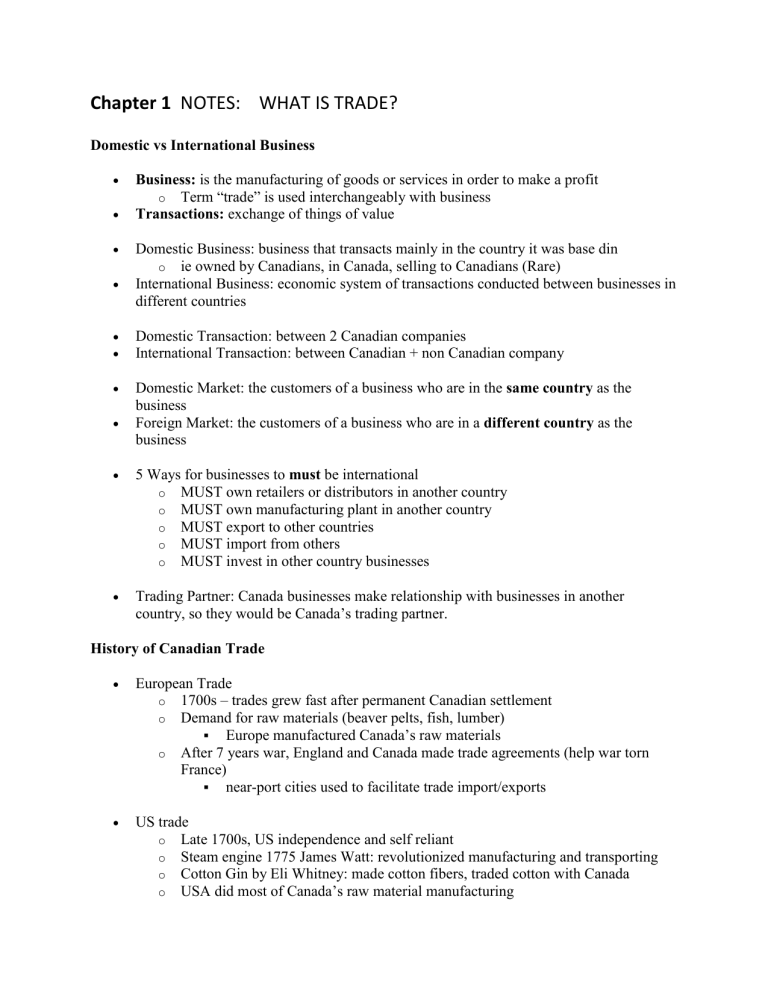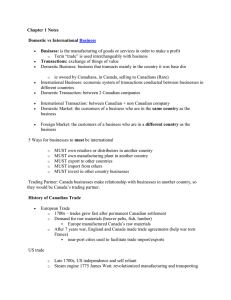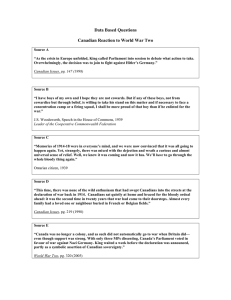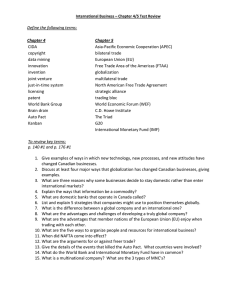
Chapter 1 NOTES: WHAT IS TRADE? Domestic vs International Business Business: is the manufacturing of goods or services in order to make a profit o Term “trade” is used interchangeably with business Transactions: exchange of things of value Domestic Business: business that transacts mainly in the country it was base din o ie owned by Canadians, in Canada, selling to Canadians (Rare) International Business: economic system of transactions conducted between businesses in different countries Domestic Transaction: between 2 Canadian companies International Transaction: between Canadian + non Canadian company Domestic Market: the customers of a business who are in the same country as the business Foreign Market: the customers of a business who are in a different country as the business 5 Ways for businesses to must be international o MUST own retailers or distributors in another country o MUST own manufacturing plant in another country o MUST export to other countries o MUST import from others o MUST invest in other country businesses Trading Partner: Canada businesses make relationship with businesses in another country, so they would be Canada’s trading partner. History of Canadian Trade European Trade o 1700s – trades grew fast after permanent Canadian settlement o Demand for raw materials (beaver pelts, fish, lumber) Europe manufactured Canada’s raw materials o After 7 years war, England and Canada made trade agreements (help war torn France) near-port cities used to facilitate trade import/exports US trade o Late 1700s, US independence and self reliant o Steam engine 1775 James Watt: revolutionized manufacturing and transporting o Cotton Gin by Eli Whitney: made cotton fibers, traded cotton with Canada o USA did most of Canada’s raw material manufacturing o o To this day, US remains as Canada’s biggest trading partner Mexico NA Free Trade Agreement (NAFTA) made duty free trade in North America Asian Trade o 1940s – Traded with Japan for electronics and cars o China manufacturing (Wal-Mart $15B to China) Trade with Middle East o Oil o Politics, lack of industrialization, and technology limited trade o Dubai, Egypt, Israel have trades asides from oil Indian Trade o High, educated population o Outsourcing and manufacturing o Although open government, lack of infrastructure and issues troubled trades o India aggressively expanded internationally Imports: Linen, Rice, diamonds, clothes Exports: fertilizers, vegetables, newspaper, copper African Trade o Very low exchange with Canada (1% import, 3% export) o Corrupt government, infrastructure problems loom o Lots of primary resource potential o South Africa (no-oil) and Morocco (oil/fruits) trading partners: Globalization and Interdependence Globalization: where economies and cultures have become integrated through new global communication, investments, trade, and transport o easy to globalize nowadays o global sales, finance, marketing, manufacturing, transportation = globalization o international business IS NOT globalization businesses can operate internationally but not globally o global businesses can be affected by global events 2008 recession Banks lent at low rates not getting returned, lost money closure of operations forced History: Globalization began after WW2 o United Nation first sign of globalization Helps negotiate treaties and tariffs Technology: Internet/cellular made trades nearly instant, quick, even at remote places Social Issues o China – India building big economies o Large companies want to expand in China/India Workers, moneyflow from huge population o Blur of political boundaries EU collaborated all Europe nations Agreements merge borders Interdependence: reliance between 2 or more nations for each other’s products and services o eg US relying on China to make goods Primary Industries: Mainly Raw materials o Agriculture, Hunting, Fishing, Energy/Mining, Forestry (FEFAH) o Western Canada: oil, gas, metals, beef o Eastern Canada: oil, offshore oil, minerals Secondary Industries: manufacturing or processing capital goods or consumer goods o Canada as good manufacturing paper, oil refining, diamond, paper o Canada relies on US and China for making other goods Branch Plant: a factory located outside of host country Canada branch plant policy saying you must have a factory to conduct business here Disadvantages of branch plants (3) Business reduction in roles mainly R&D and execs Innovation follows parent company Exports lack – made in Canada for Canadians Non-Canadian Materials – uses imported materials often Foreign secondary + domestic secondary can add value to raw materials Tertiary Industries: provides services for consumers and businesses o Retail is the largest (banking, construction, communication) Canadian retail depend on imports Most Canadian retails are owned by foreign places How International business help Canadians Variety of products o most products made in USA, but we have access to those o experiences from around the world o electronics mostly imported o benefit from cheap labour and materials in China and India New Markets, More Jobs o 34 M pop’n in Canada, 100M pop’n in USA, 1B+ pop’n in China o BL: make products that suit Chinese demographics o Tim Hortons USA locations mean they hire more people o Foreign companies in Canada spend more money on R&D Foreign Investments o (1) Foreign Direct Investments (FDI): done to control all or some of business’ operations (startups) o (2) Foreign Portfolio Investments: stocks/bonds/funds issued by companies to own a part of it o HBC went bankrupt if it wasnt for foreign investments backing them up New processes and Technology o medical, consumer electronics How International business hurts Canadians Loss of culture/identity o Movies are mostly representing American culture, rare about Canada CRTC regulates how much Canadian TV shows are shown in Canada 35% of radio music must be canadian M – Music A – Artist P – Produced L – Lyrics Canadians are often aware of Canadian books and TV shows due to recognition o Increased foreign ownership of Canadian companies Foreign companies are likely to stay loyal to their come country often leaves Canada in the dark when corporate problems rise R&D is often left in home country, making such jobs not in Canada and lowered profits Reduced Exports: foreign branch in Canada does things for Canada and doesnt export Revenues leave Canada pay head offices: Canadian branch helps pay head office costs This lowers actual income and lesser taxation. High jobs like accounting, advertising, and marketing is done in home country Economic destabilization, Global events can influence and impact Canadian economy due to many plugins from foreign businesses Eg 2008 American “Buy American” campaign negatively affected CDN economy.




